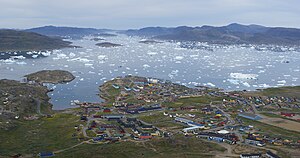Narsaq
|
Narsaq Nordprøven |
|
|---|---|

Narsaq skyline from Qaaqarsuaq mountain
|
|
| Location within southern Greenland | |
| Coordinates: 60°54′44″N 46°02′55″W / 60.91222°N 46.04861°WCoordinates: 60°54′44″N 46°02′55″W / 60.91222°N 46.04861°W | |
| State |
|
| Constituent country |
|
| Municipality |
|
| Founded | 1830 |
| Population (2013) | |
| • Total | 1,503 |
| Time zone | UTC-03 |
| Postal code | 3921 |
| Website | narsaq.gl |
Narsaq or Narssaq is a town in the Kujalleq municipality in southern Greenland. The name Narsaq is Kalaallisut for "Plain", referring to the shore of Tunulliarfik Fjord where the town is located.
People have lived in the area for thousands of years, but not continuously. Remains of the Norse settlement can be found in the area. The church ruins of Dyrnæs can be found on the north-western outskirts of the town. The Landnám homestead, Landnamsgaarden, can be found immediately to the west of the town. Dated to the year 1000, the homestead is among the oldest of the Norse ruins in the area. The wider Narsaq area has some of the most striking Norse artefacts and ruins. Erik the Red's Brattahlid is located in present-day Qassiarsuk, and the Gardar bishop seat is in present-day Igaliku.
Present day Narsaq was founded as Nordprøven ("North Prøven") in 1830, distinguishing it from Sydprøven ("South Prøven", modern Alluitsup Paa) established the same year. The initial settlement was founded as a trading colony of Qaqortoq, then named Julianehaab.
A trading center was established here due to the natural deep water harbor which could accommodate ocean faring vessels, . Initially local seal hunters traded blubber and seal skin for continental goods, such as coffee, sugar, bread and buckwheat.
Until approximately 1900 seal hunting formed the main economy for Narsaq. In the early 1900s seal hunting began to fail, and the main basis for the economy gradually shifted to fishing. The city's historical fishing village is from 1914. The main house of the historical village today houses the power company in the city.
Simiutak at the Skovfjord mouth near Narsaq was a HF/DF radio range finding station called Bluie West Three during World War Two. The station commenced operations in January 1942, and was permanently manned until the end of the war.
...
Wikipedia

